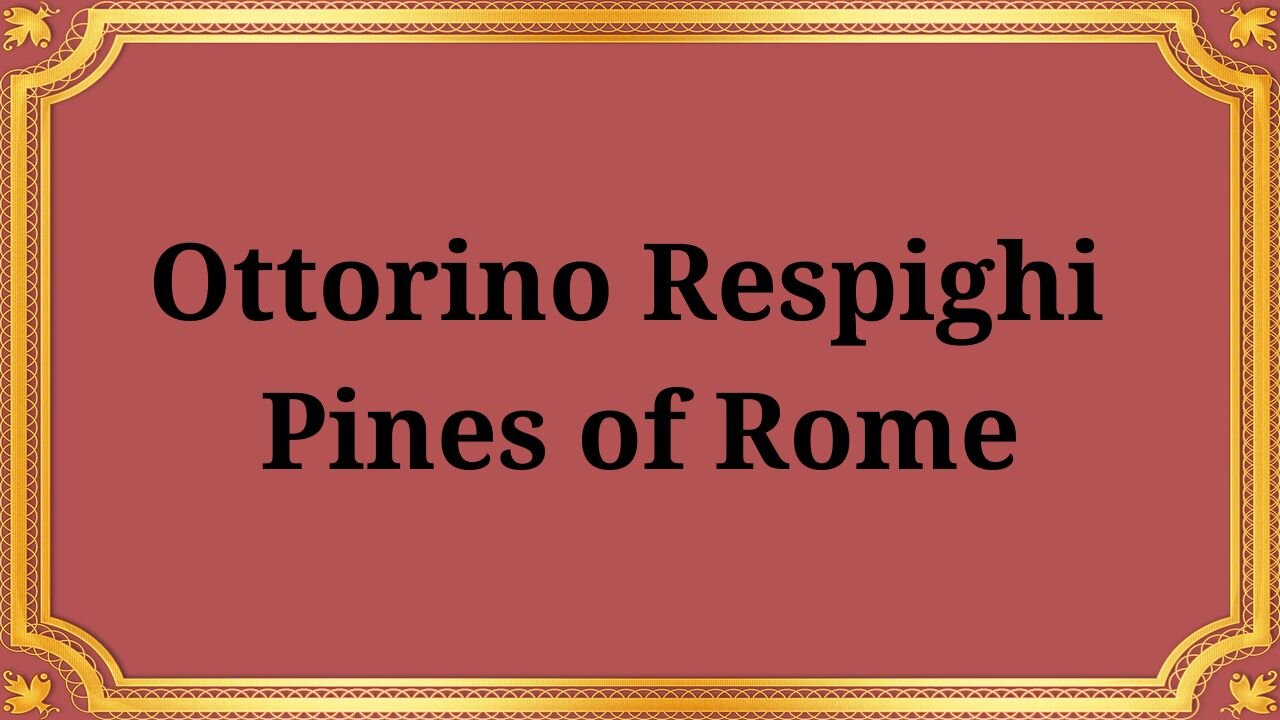Premium Only Content

Ottorino Respighi "Pines of Rome"
#Classical #Impressionism #Modern #Respighi #Pines_of_Rome #orchestral_tone_poem#Roman_landscapes #20th_century_classics #rarity
Date of publication: 1948
Philadelphia Orchestra; Eugene Ormandy
Ottorino Respighi's symphonic poem Pini di Roma (Pines of Rome), written in 1924, is one of the most vivid musical portraits of Rome in Western music. In its four movements, Respighi combines lush orchestration, vibrant orchestral color, and programmatic narrative to evoke specific places and times in the city's ancient and modern life. The work is noted for its cinematic sense of drama, masterful use of tone painting, and the way it conveys the grandeur and intimate moments of Roman life. Respighi wrote Pines of Rome after a period of study and travel in Italy, drawing on his fascination with the landscape, history and memory of Rome. The work is a symphonic suite in four movements, each dedicated to a specific scene or place in the city:
1) “Pastoral” Dawn on the Appian Way: The first movement begins with a serene, almost pastoral appearance in the countryside. A solo English horn and a muted trumpet create the feeling of a quiet Roman morning, when shepherds and farmers begin their day. The music opens in a gentle, pastoral mood and gradually turns into a more intense, lyrical lyricism.
2) “Sparks” of the Aqueduct: In the second movement, Respighi recreates the energy and bustle of the Roman outskirts and train stations, where workers and machines create a noisy, metallic, almost industrial soundscape. The tonal language evokes a city awakening to a mechanized rhythm intertwined with triumphant, martial fanfares that hint at the enduring grandeur of Rome. 3) Roman Holiday in country villas: The third movement paints a festive scene - the music alternates dance rhythms, rustic chants and choral exclamations of brass instruments, evoking associations with processions and public merriment. A majestic march gives way to a playful, capriccio-like section that conveys the spirit of secular life in the late afternoon light. 4) Pontiffs in sacred places: The final movement returns to a monumental, ceremonial mood. A solemn and majestic procession, culminating in a bright, inspiring chord, evokes associations with ancient rites and the Christian heritage that also shaped Roman identity. The music builds into a monumental piece of brass and percussion instruments, presenting a timeless, almost spiritual panorama of the city.
Respighi is known for his orchestral color and ability to create “tonopoeic” sounds. Pines of Rome is a showcase of his mastery of orchestration: color effects, written percussion, and carefully constructed melodies. The work features:
– Rich, vibrant orchestration: strings, woodwinds, brass, and percussion are used graphically to depict landscapes, horizons, and crowds.
– Programmatic clarity: although not as overt as some programmatic works, each movement paints a recognizable scene through musical motifs and textures.
– Innovative use of rhythm and timbre: the work uses contrasting tempos and rhythmic meters to convey a pastoral dawn, industrial energy, secular celebration, and sacred procession.
– A modern classic with ancient echoes: While clearly an early 20th-century work, Pines often draws on medieval and Renaissance sounds – echoes that link modern Rome to its long-held historical memory. Respighi’s Pines of Rome emerged at a time when composers were exploring national identity and local colour through orchestral colour. An Italian composer associated with late Romantic harmonies and the early modern preoccupation with timbre, Respighi used Rome as a living orchestral canvas. The work’s combination of serenity, bustle, celebration and ceremony reflects the city’s complexity: its ancient ruins sit alongside modern streets, its sacred institutions alongside secular life. The work’s influence extends beyond the concert hall. Its cinematic sensibility anticipated the emphasis of later film music on mood, place and narrative movement. Respighi's "Pines of Rome", along with his other works inspired by Rome - "Fountains of Rome" and "The Roman Trilogy" - cemented his reputation as a master of tone painting and a composer who could convey the atmosphere of the city with orchestral color.
-
 8:57
8:57
Classical music_Music Inspiration
4 days agoTomaso Albinoni Adagio in G minor for double bass
292 -
 5:13
5:13
Buddy Brown
6 hours ago $0.78 earnedMuslim PATROL CARS Begin Monitoring NYC! | Buddy Brown
6235 -
 12:54
12:54
MetatronGaming
2 hours agoYou Remember Super Mario WRONG and I can Prove it
1324 -
 1:02:55
1:02:55
Russell Brand
3 hours agoThe Epstein Files Are Coming — And The Establishment Is Terrified! - SF653
67.2K13 -
 32:47
32:47
The White House
3 hours agoPresident Trump Meets with Zohran Mamdani, Mayor-Elect, New York City
10.1K44 -
 1:07:21
1:07:21
The Quartering
2 hours agoPeace Between Ukraine & Russia? Kimmel Meltdown & More layoffs
15.8K10 -
 LIVE
LIVE
Barry Cunningham
3 hours agoBREAKING NEWS: PRESIDENT TRUMP MEETS WITH COMMIE MAMDANI | AND MORE NEWS!
1,634 watching -
 LIVE
LIVE
LadyDesireeMusic
1 hour agoLive Piano Music & Convo | Anti Brain Rot | Make Ladies Great Again | White Pill of the Day
94 watching -
 LIVE
LIVE
StoneMountain64
3 hours agoArc Raiders Making Money and LEVELING Up
107 watching -
 LIVE
LIVE
ReAnimateHer
5 hours agoNell’s Diner Is OPEN… For Your Final Meal
38 watching